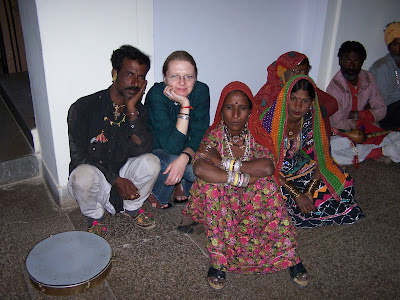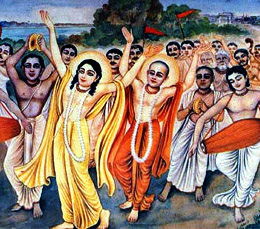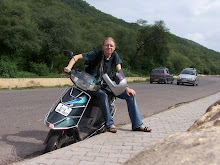Recently I went for a few days to Pushkar – for a Hindi Shivir (Hindi gathering), which was organized by my school in Jaipur. All teachers and all students were present there, students attending Hindi course in Delhi, in the headquarters of the AIIS were also with us. The basic principle of the outing was to test us in our Hindi skills – the test required public performances and various tasks and homeworks that could be only completed by interviewing Pushkar vasis. Initially I was dreading the Hindi performance, especially because I am not a performer. I had clear flashbacks of all my performances from my kindergarten times – and I am telling you – it wasn’t fun! Anyhow, since we were all marked on our performance part, I had to do it. I managed to get through by singing bhajans and giving class in Hindi. My first ever Hindi pravacan, wah! Teachers made an asana for me and even gave me a garland.
Pushkar is famous for it’s temple of Lord Brahma. In fact, it has apparently 400 shrines, but the most important are dedicated to Brahma, Vishnu, Varaha, Savitri and Gayatri. Lord Brahma’s lotus flower fell in three separate places in the Pushkar area, and at each place water came from the ground, creating lakes. Brahma threw the pushpa (flower) with his kar (hand), hence the name Pushkar. Padma Purana states also that Lord Brahma with this lotus flower killed a demon.
Story says that during the Kartik Purnima Brahmaji wanted to perform a sacrifice and was looking for a suitable place. Since the lotus that dropped here created three lakes, it was here where Brahma decided to perform his yajna. To perform the sacrifice the presence of his wife Savitri was required; however, she was late. Brahma requested thus Indra to arrange another marriage for him, so that the sacrifice could go on. The priest manifested a daughter called Gayatri. When Savitri finally arrived and saw what happened, out of anger she cursed Brahma that he wouldn’t be worshiped in any other place around the world, only here, in Pushkar. Hence the Brahmaji Mandir in Pushkar is of a great significance.

Pushkar has certainly a spiritual atmosphere and it has it’s unique twist. Due to the influx of videshi tourists (mostly from Israel), it is a mixture of a spiritual culture and a hippie paradise.

The sacred lake created by Brahmaji. Whoever takes bath here will go to heaven and will never be born again in the material world.
 Every evening an arati is performed on the ghats of the lake.
Every evening an arati is performed on the ghats of the lake.
Lord Brahma.



Group of ladies from Gujarat whom I have interviewed in front of the Brahma temple. After having darshan in Pushkar they were all heading to Nathadwar to see Lord Nathaji.


My teachers – Rashmiji and Anitaji.

My teacher – Nilamji - presents the sum and substance of Indian existence – chai (tea) and snacks!

Nilamji, Zain and me are ready for a rocking kirtan!

Here I am getting my homework done – translating Hindi into Marvar – a rajasthani dialect.

 The color of Rajasthan!
The color of Rajasthan! 
I also made friends with some local artists.
 Varanasi - the city of lights, city that gives liberation, place for Gangaji worship, hippie paradise, cremation ghats and a good university - a blend of it all!
Varanasi - the city of lights, city that gives liberation, place for Gangaji worship, hippie paradise, cremation ghats and a good university - a blend of it all! Typical little, narrow gallies of Kashi. My Hindi teachers from here (Jaipur) are mostly Varanasi-vasis. They say that these little gallies were designed to be narrow like that on the purpose. In case of a Mughal army attack - not many soldiers could squeeze in such a narrow space all at once!
Typical little, narrow gallies of Kashi. My Hindi teachers from here (Jaipur) are mostly Varanasi-vasis. They say that these little gallies were designed to be narrow like that on the purpose. In case of a Mughal army attack - not many soldiers could squeeze in such a narrow space all at once!

 Zorro in Kashi! Actually not, he was a French tourist, and I have no idea why he was always dressed like that! I have bumped into him on several occasions, within a few days.
Zorro in Kashi! Actually not, he was a French tourist, and I have no idea why he was always dressed like that! I have bumped into him on several occasions, within a few days. The Devatas and me!
The Devatas and me! Gangaji.
Gangaji. Famous Ganga arati at the Dasasvamedha Ghat.
Famous Ganga arati at the Dasasvamedha Ghat. Here my Mother is ready to do her own offering too!
Here my Mother is ready to do her own offering too!


 Me loitering around on the grounds of the BHU - Benares Hindu University. They have a great campus with many department buildings. Some years ago I was considering studying there, but somehow or other I ended up at SOAS in London instead.
Me loitering around on the grounds of the BHU - Benares Hindu University. They have a great campus with many department buildings. Some years ago I was considering studying there, but somehow or other I ended up at SOAS in London instead. These riksha wallas are friends of my fellow students in Jaipur. 3 years ago our Hindi Language Program was based in Varanasi, before it was finally shifted to Rajasthan.
These riksha wallas are friends of my fellow students in Jaipur. 3 years ago our Hindi Language Program was based in Varanasi, before it was finally shifted to Rajasthan.


































